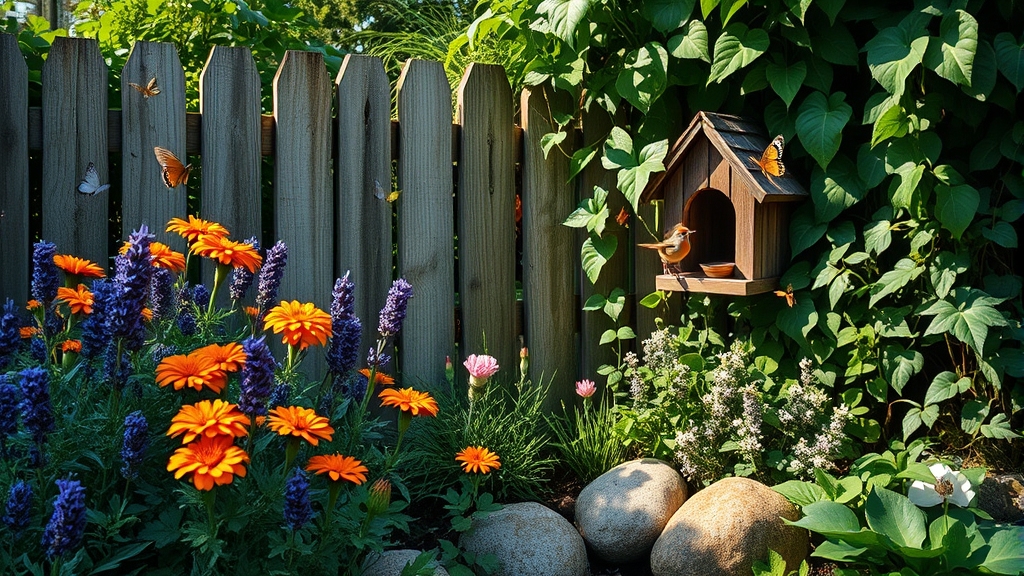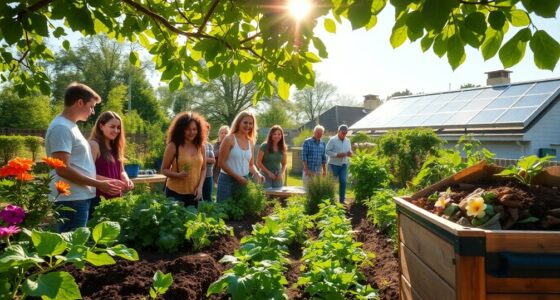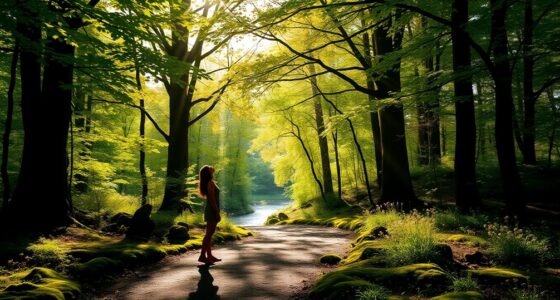Transforming your garden into a wildlife haven involves creating pollinator corridors with native plants, which connect fragmented habitats and support bees, butterflies, and other pollinators. Incorporate a variety of flowering plants that bloom at different times, along with layered habitats like shrubs and grasses, to provide food and shelter. By adding native plantings and establishing undisturbed patches, you help sustain ecosystems and boost biodiversity. Keep exploring to discover more ways to turn your garden into a crucial conservation space.
Key Takeaways
- Incorporate native plants that bloom at different times to provide continuous food sources for pollinators.
- Create layered habitats with shrubs, ground covers, and tall grasses to support diverse wildlife.
- Establish small, undisturbed native patches as sanctuaries to promote biodiversity.
- Connect your garden with local habitats using pollinator corridors for wildlife movement.
- Reduce resource use by choosing resilient native plants, making your garden sustainable and wildlife-friendly.

Backstage conservation plays a essential role in safeguarding our natural and cultural heritage, yet it often goes unnoticed by the public. When you think about protecting wildlife and preserving ecosystems, it’s easy to focus on national parks or large conservation projects. But your own backyard can be a fundamental part of this effort. By transforming your garden into a wildlife haven, you contribute to broader ecological health. One of the most effective ways to do this is by creating pollinator corridors—strips of native plants that connect fragmented habitats, allowing bees, butterflies, and other pollinators to move safely and find resources. These corridors serve as critical pathways, supporting not just individual species but entire ecosystems that depend on pollination for reproduction and food production.
Transform your garden into a wildlife haven with native plants and pollinator corridors supporting ecosystems and biodiversity.
In addition to establishing pollinator corridors, planting native species is essential. Native plantings are adapted to your local climate and soil, making them resilient and low-maintenance. They provide indispensable food and shelter for local wildlife, including insects, birds, and small mammals. When you choose native plants, you’re creating a more sustainable and thriving environment that requires fewer resources like water and chemical inputs. This natural approach reduces your garden’s ecological footprint while enhancing biodiversity. Think of your garden as a micro-ecosystem where each native plant attracts specific pollinators, creating a balanced and self-sustaining habitat.
Incorporating native plantings also encourages a natural flow of species, making your garden more resilient to pests and extreme weather. You can start by researching which native plants are best suited to your area, then gradually replacing or supplementing your existing landscaping. Incorporate a variety of flowering plants that bloom at different times of the year, ensuring a continuous source of nectar and pollen. Add layered habitats—shrubs, ground covers, and tall grasses—to support diverse wildlife needs. Creating small, undisturbed patches of native plants can serve as sanctuaries for insects and small creatures, reinforcing the ecological network beyond your property.
Furthermore, designing your garden with pollinator corridors in mind helps connect fragmented habitats, making it easier for wildlife to thrive across the landscape. These corridors can be simple strips along fences or pathways lined with native flowering plants. Over time, your efforts can inspire neighbors and community groups to adopt similar practices, amplifying the conservation impact. When you embrace native plantings and establish pollinator corridors, you’re not just beautifying your garden—you’re actively participating in backstage conservation, helping sustain essential species and ecosystems that benefit everyone.
Frequently Asked Questions
How Can I Attract Specific Native Bird Species to My Garden?
To attract specific native bird species, you should provide the right habitat. Use bird feeders with appropriate seeds for your target species, and install nesting sites like boxes or shrubs they prefer. Keep your garden pesticide-free to guarantee food safety. By creating a welcoming environment with natural plants and water sources, you make your garden irresistible to your favorite native birds, encouraging them to visit and stay.
What Are Eco-Friendly Ways to Manage Pests Naturally?
You can manage pests naturally by encouraging beneficial insects, which control pests without chemicals. Create beneficial insect habitats using native plants and avoid pesticides. Implement eco-friendly composting techniques to enrich your soil naturally, reducing plant stress and pest attraction. These strategies promote a healthy garden ecosystem, helping pests stay in check while supporting native wildlife. With patience, your garden becomes balanced and resilient, thriving in harmony with nature.
How Do I Create a Pond That Supports Local Wildlife?
Creating a wildlife-friendly pond is easier than you think and will greatly enhance your garden. Start by choosing a natural, sustainable water feature that blends seamlessly into your landscape. Use native plants around the pond to attract insects and birds, and avoid chemicals. This sustainable water feature supports local wildlife and promotes eco-friendly, wildlife-friendly landscaping. Imagine the vibrant activity and natural beauty your pond will bring to your garden every day.
Which Native Plants Are Best for Supporting Pollinators?
When selecting native plants for pollinator-friendly gardening, focus on species that provide nectar and pollen throughout the year. Native plant selection is essential because it supports local pollinators like bees, butterflies, and hummingbirds. Consider planting lavender, bee balm, coneflowers, and milkweed, which attract and sustain pollinators. By choosing native plants, you create a thriving habitat that benefits pollinator populations and enhances your garden’s natural beauty.
How Can I Prevent Invasive Species From Taking Over My Garden?
Think of invasive species as relentless invaders trying to choke out your native plant allies. To prevent this, stay vigilant with invasive species control by regularly inspecting your garden and removing unwanted plants early. Focus on native plant preservation, which naturally outcompetes invaders. Use native species in planting, and avoid introducing non-native plants that threaten your garden’s delicate balance. This way, your garden remains a thriving, resilient haven for local wildlife.
Conclusion
By transforming your garden into a wildlife haven, you’re planting the seeds of hope and resilience. Every flower you nurture and insect you welcome becomes a symbol of harmony, reminding you that even the smallest actions can create a ripple effect. Like a quiet guardian, your efforts protect the delicate balance of life, ensuring nature’s symphony continues to play. Embrace this role, and watch your garden become a sanctuary where wildlife and wonder flourish together.







